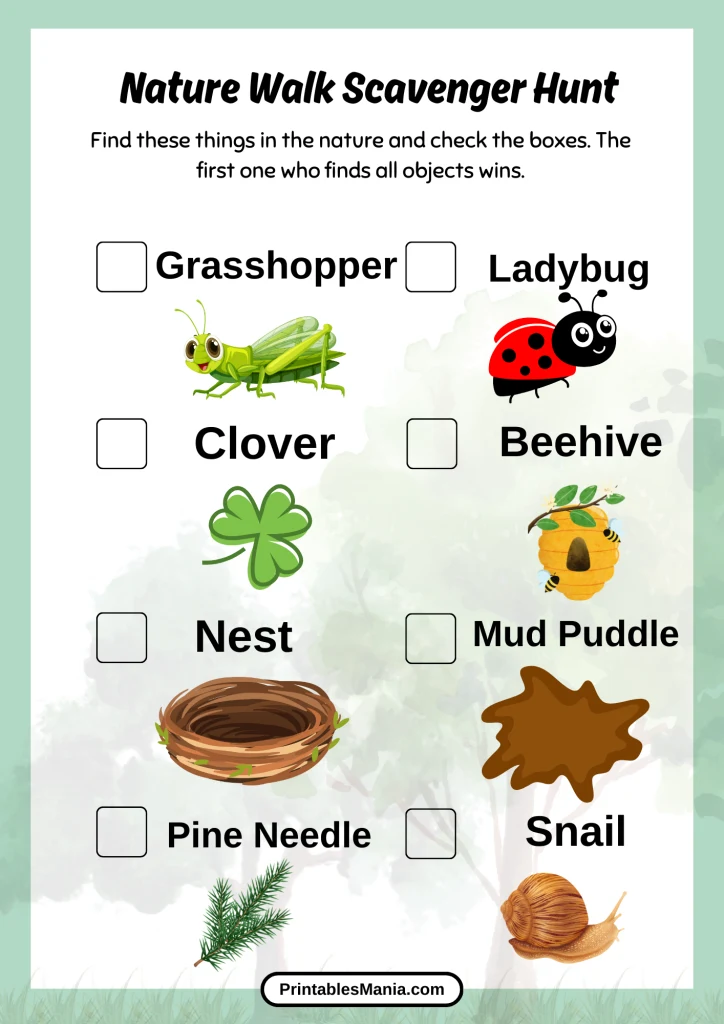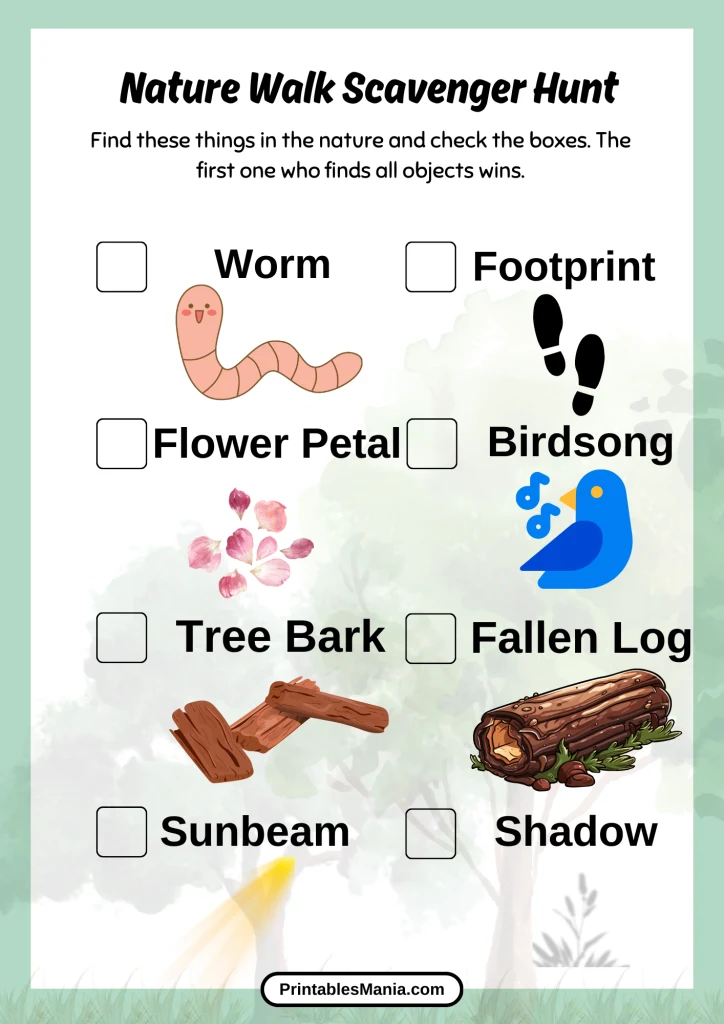If you’re looking for a fun and educational activity to do with your kids, you’ve come to the right place. Our free printable scavenger hunt is perfect for engaging children with the wonders of the outdoors. Whether you’re exploring a local park, hiking a nature trail, or just enjoying your backyard, this scavenger hunt will provide hours of entertainment and learning.
Benefits of a Nature Walk Scavenger Hunt
Engaging in a nature walk scavenger hunt offers numerous benefits for children:
- Encourages Outdoor Exploration: Helps kids connect with nature and develop a love for the outdoors.
- Enhances Observational Skills: Sharpens their ability to notice details in their surroundings.
- Promotes Physical Activity: Encourages walking, running, and exploring in a fun and exciting way.
- Stimulates Curiosity and Learning: Sparks interest in plants, animals, and natural phenomena.
- Fosters Family Bonding: Provides an excellent opportunity for families to spend quality time together.
How to Use the Free Printable
Using our free printable scavenger hunt is easy and convenient:
- Download and Print: Simply download the PDF file and print it out on your home printer.
- Gather Supplies: You’ll need a clipboard or a hard surface to write on, a pencil or marker, and the printed scavenger hunt sheet.
- Start Exploring: Head outside and begin your adventure. Look for the items on the list and check them off as you find them.
- Celebrate Your Finds: Take photos of your discoveries and share them with family and friends. You can also discuss what you found and learned during your walk.
Tips for a Successful Scavenger Hunt
To make the most of your nature walk scavenger hunt, keep these tips in mind:
- Dress Appropriately: Wear comfortable clothing and sturdy shoes suitable for walking and exploring.
- Bring Essentials: Carry water, snacks, sunscreen, and insect repellent to ensure a pleasant experience.
- Stay Safe: Supervise children at all times and be aware of your surroundings.
- Be Respectful of Nature: Teach kids to respect wildlife and plants by not disturbing or damaging them.
- Make it Fun: Encourage curiosity and excitement. Turn the hunt into a game and celebrate each find.
Download Your Free Printable
Ready to start your adventure? Download your free printable nature walk scavenger hunt below and get ready for a fantastic outdoor experience with your kids! We hope you enjoy your nature walk scavenger hunt and create wonderful memories with your children. Happy exploring!










Age-Appropriate Variations
Creating age-appropriate variations for your nature walk scavenger hunt can help engage children at different developmental stages. Here are some suggestions tailored to various age groups:
Toddlers (Ages 2-4)
For the youngest explorers, keep the scavenger hunt simple and focused on easily identifiable items. Use pictures instead of words to help non-readers participate.
- Simple Checklist: Include items like a red leaf, a big rock, a small stick, or a yellow flower.
- Sensory Exploration: Encourage toddlers to touch different textures, like smooth rocks, rough bark, and soft leaves.
Preschoolers (Ages 4-6)
Preschoolers can handle more complexity and enjoy a bit more challenge.
- Color and Shape Hunt: Include items of specific colors and shapes, like a round rock or a green leaf.
- Simple Descriptions: Add a few descriptive words, such as “a shiny rock” or “a fluffy feather.”
Early Elementary (Ages 6-8)
Children in this age group can start to explore more detailed and varied items.
- Themed Hunts: Introduce themes like “Signs of Spring” or “Bug Hunt” to make it more exciting.
- Basic Facts: Include a few basic facts about the items to encourage learning, such as “Find a leaf that has fallen from an oak tree.”
Older Children (Ages 8-12)
Older children can handle more complex tasks and can be encouraged to explore nature in greater depth.
- Scientific Observations: Encourage them to take notes or draw what they find, noting differences between items.
- Challenge Tasks: Add tasks like “Find three different types of leaves and identify the trees they came from” or “Spot a bird and try to identify it.”
By tailoring the scavenger hunt to different age groups, you can ensure that all children are engaged and challenged appropriately, making the activity both fun and educational.
Environmental Stewardship Tips
Teaching children about environmental stewardship during a nature walk scavenger hunt instills a sense of responsibility and respect for nature. Here are some tips to promote environmental stewardship:
Leave No Trace
Teach children the principles of “Leave No Trace” to minimize their impact on the environment.
- Take Only Memories: Encourage children to look and learn but not to take natural items home with them.
- Leave What You Find: Explain the importance of leaving rocks, plants, and other natural items where they are found to preserve the ecosystem.
Respect Wildlife
Help children understand the importance of respecting all living creatures.
- Observe Quietly: Teach them to observe animals from a distance without disturbing them.
- Avoid Feeding Wildlife: Explain why feeding wild animals can be harmful to them.
Stay on Trails
Promote the use of designated paths to protect the natural environment.
- Prevent Erosion: Explain how staying on trails helps prevent erosion and protects plant life.
- Safety First: Emphasize that staying on marked paths keeps them safe and prevents them from getting lost.
Clean Up
Involve children in picking up litter to keep natural areas clean.
- Bring a Bag: Carry a small bag to collect any litter you find along the way.
- Recycle: Teach them to sort recyclable materials and dispose of trash properly.
Conserve Water
Encourage water conservation practices during outdoor activities.
- Stay Hydrated: Bring reusable water bottles instead of disposable ones.
- Protect Water Sources: Explain the importance of not contaminating streams, rivers, and lakes.
Plant and Animal Identification
Use the scavenger hunt as an opportunity to teach about local flora and fauna.
- Identify Plants and Animals: Bring a guidebook or use a smartphone app to help identify plants and animals.
- Learn About Ecosystems: Discuss the roles different plants and animals play in their ecosystems.
By incorporating these environmental stewardship tips into your nature walk scavenger hunt, you can teach children to appreciate and care for the natural world, fostering a lifelong respect for the environment.







